The long-awaited James Webb Space Telescope has a big to-do list
The instrument will probe mysteries, such as 'dark energy,' and search for life on distant worlds
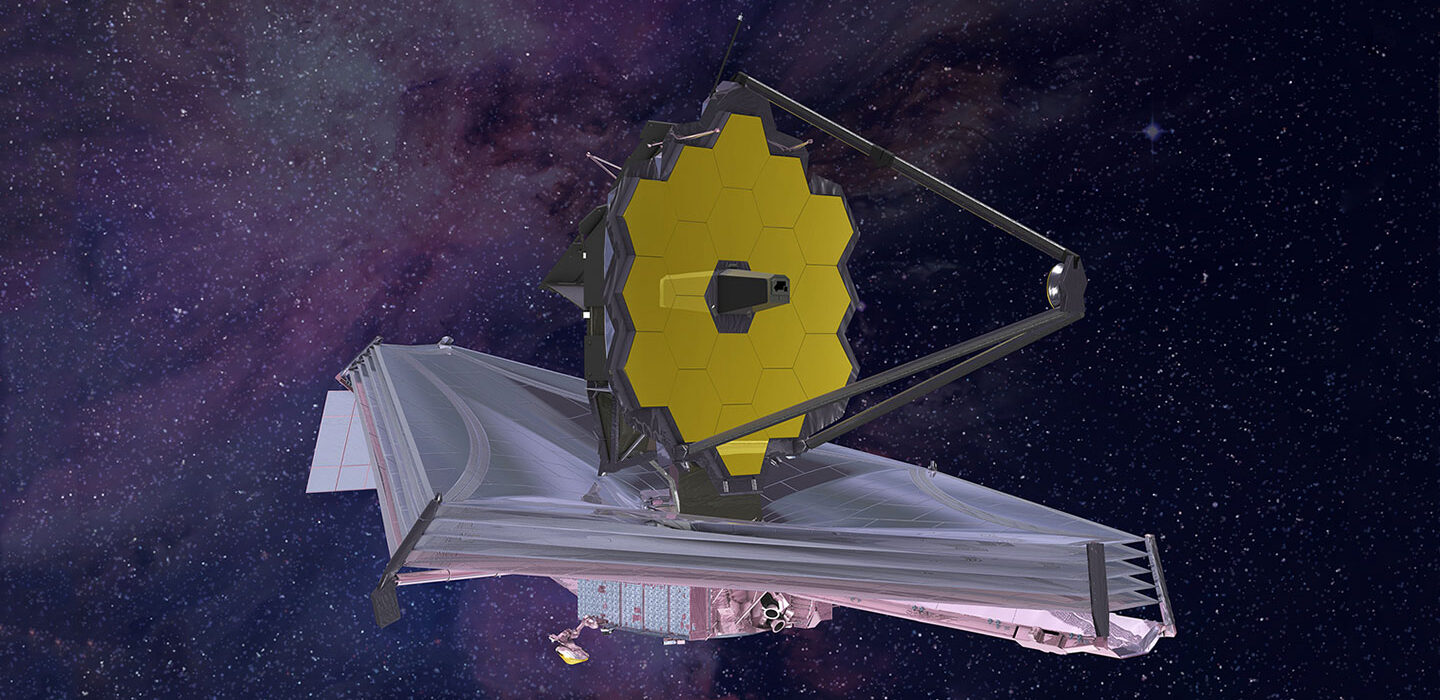
This is an artist’s representation of what the unfurled James Webb Space Telescope would look like in space. It’s the biggest, most complex telescope ever launched into space.
NASA
The James Webb Space Telescope has been a long time coming.
Scientists have been planning this mission since 1989. It was supposed to launch between 2007 and 2011. But the telescope was more difficult and costly than anyone expected. So the launch date got pushed back by more than a decade. Finally, in December, the Webb telescope blasted off into space. It is the largest and most complex telescope ever sent into orbit.
The telescope’s basic design hasn’t changed much over the years. But you know what has? The science that Webb can dig into. Back when scientists first imagined this telescope, they hadn’t yet discovered dark energy. (This is a mysterious force pushing the universe to expand.) Astronomers also hadn’t yet discovered exoplanets — planets orbiting other stars. Those recent advances have raised big questions about the universe. And the James Webb Space Telescope could be a great tool to help answer them.
“It’s been over 25 years,” says Wendy Freedman. She’s a cosmologist at the University of Chicago in Illinois. “But I think it was really worth the wait.”

Educators and Parents, Sign Up for The Cheat Sheet
Weekly updates to help you use Science News Explores in the learning environment
Thank you for signing up!
There was a problem signing you up.
A bold plan
Webb has a unique design. Most space telescopes house a single lens or mirror within a tube. That tube keeps sunlight from blinding the telescope to dimmer lights. Those lights could be stars or other distant celestial objects. But Webb’s huge 6.5-meter-wide (21-foot-wide) mirror isn’t inside a tube. Instead, a shield the size of a tennis court blocks out the sun. It also blocks out sunlight reflecting off Earth and the moon.
Webb’s big mirror and shield are an awkward shape to fit on a rocket. So Webb launched folded up. The massive machine unfurled itself in space.
“They call this the origami satellite,” explains Scott Friedman. This astronomer works at the Space Telescope Science Institute. It’s in Baltimore, Md. Friedman was in charge of unfolding Webb in space. “Webb is different from any other telescope that’s flown.”
A novel design
The James Webb Space Telescope’s sun shield spans the length of a tennis court. This shield protects the telescope’s mirrors from light and heat from the sun, moon and Earth. The telescope’s solar panels, exposed to the sun, convert light to electricity to power the instruments. Webb’s antenna helps it send data to scientists on Earth. The stabilization flap keeps the machine from veering off course.
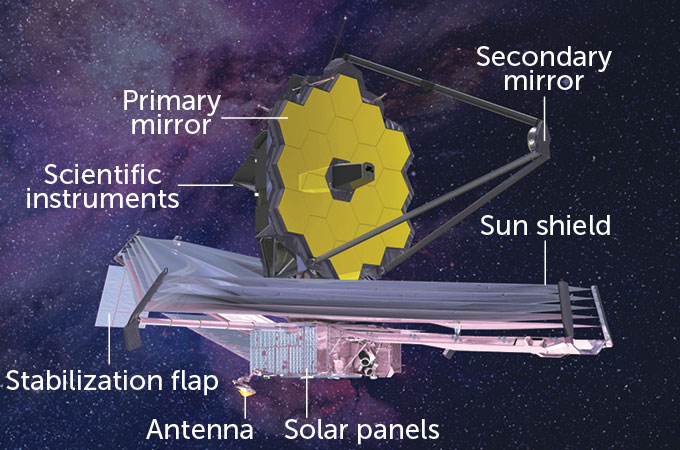
Webb’s strange design was always part of the plan. The telescope was first dreamed up in 1989 as a successor to the Hubble Space Telescope, which was about to launch. Astronomers wanted the newer telescope to see light at infrared wavelengths. That would complement Hubble’s ability to see ultraviolet, visible and near-infrared light. Scientists also wanted the telescope after Hubble to have an even bigger mirror. Hubble’s mirror is about 2.4 meters, or eight feet, wide. A bigger mirror would be able to collect more light. The more light a telescope can collect, the farther it can see into space.
Ideally, the telescope to follow Hubble would have a mirror at least six meters (20 feet) wide. But no mirror that size had ever flown in space. No available launch vehicles could carry it. Scientists would have to design a telescope mirror that could fold. The telescope would also need a foldable sun shield. A big one. Thus, the origami telescope was born.
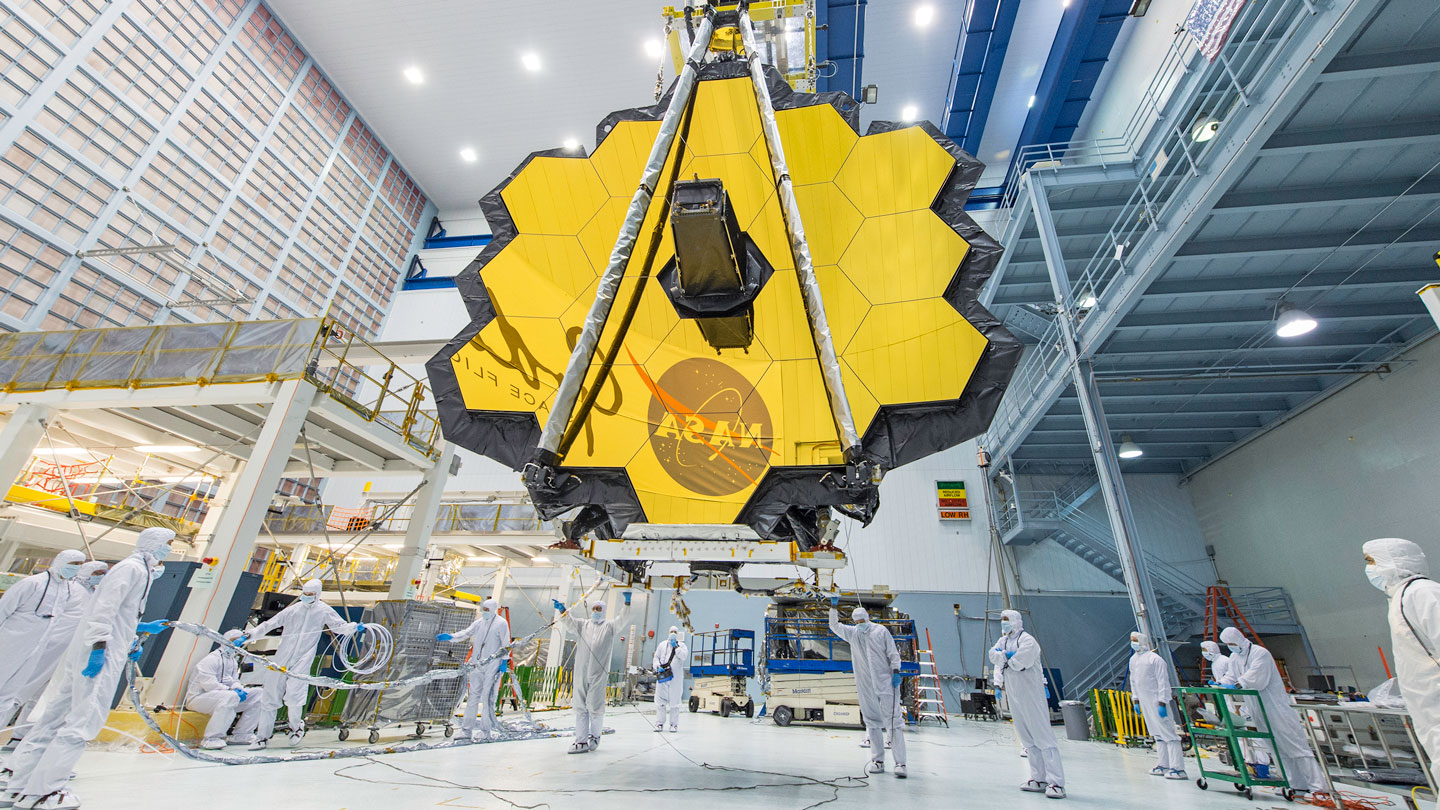
It was a big undertaking. The project was delayed several times because building and testing the spacecraft took so long. Other slowdowns were because of human errors. For instance, someone used the wrong cleaning solvent on the telescope. This mistake damaged valves in the propulsion system. More recently, shutdowns due to the coronavirus pandemic also pushed the launch back.
“I don’t think we ever imagined it would be this long,” says Freedman. But there’s one silver lining: Science marched on.
Looking back in time
One of Webb’s original goals was to study galaxies like our own Milky Way. That is still the dream, partly because it’s such an ambitious goal.
“We wanted a science rationale that would resist the test of time,” says Massimo Stiavelli. “We didn’t want to build a mission that would do something that gets done in some other way.” Stiavelli is an astronomer at the Space Telescope Science Institute. He has been a leader on the James Webb Space Telescope project.
Webb will peek at galaxies and stars as they were just 400 million years after the Big Bang. At that time, the universe was about 3 percent of its current age. This is when astronomers think the universe became transparent to light. Before that, all matter existed in a soup of charged particles. Light struggled to get very far through that particle soup.
Webb can see so far back in time because it observes infrared light. These wavelengths are too long for the human eye to see. But these are the wavelengths where a telescope can see the earliest objects in the universe. Here’s why:
Light travels at a fixed speed. So it takes time for light from any distant objects to reach us. Looking at very far-off objects means we’re seeing them as they were long ago. Since the universe is expanding, light from those early, distant objects gets stretched out before reaching our telescopes. For the farthest, earliest objects out there, that light gets stretched out to infrared wavelengths.
Mixed views
Webb will observe the universe in wavelengths that are mostly longer than what humans can see. (The human eye can see wavelengths from 0.38 to 0.7 micrometer. Webb will look at wavelengths 0.6 to 28.5 micrometers.) Webb will also observe wavelengths that are longer than what the Hubble Space Telescope can observe, yet shorter than most of the Spitzer Space Telescope’s range. This infrared view lets Webb see far out into the universe.
Electromagnetic spectrum
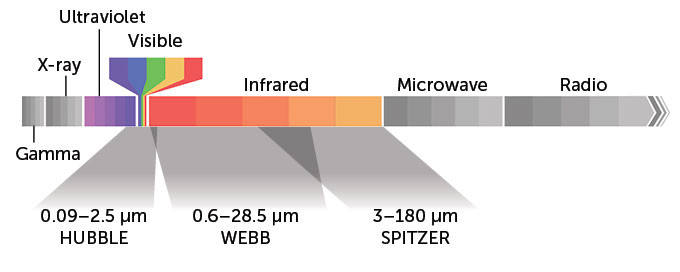
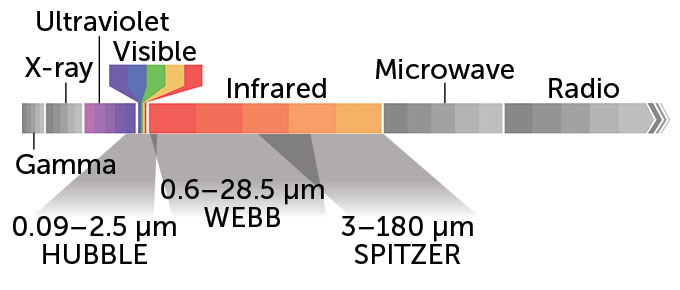
In the 1990s, astronomers wanted to look at the early universe to solve a problem. Back then, the universe was thought to be 8 billion or 9 billion years old. But some stars seemed to be about 14 billion years old.
“You can’t have a universe that’s younger than the oldest stars,” Freedman says. “The way people put it was, ‘You can’t be older than your grandmother!’”
In 1998, cosmologists solved that mystery. It turned out, the universe was expanding faster and faster. If that was true, then the universe must be older than astronomers thought. The current age estimate is about 13.8 billion years old. Scientists call the mysterious substance that drives the universe’s accelerating expansion “dark energy.”
“That resolved the age conflict,” Freedman says. “The discovery of dark energy changed everything.” And it gave Webb another realm to explore. For one thing, astronomers can’t agree on how fast the universe is expanding. Now, the top of Webb’s to-do list is resolving that disagreement.
Getting there
Webb orbits the sun from a stable point in space called L2. This position is 1.5 million kilometers (932,000 miles) from Earth. The telescope is spending its first month after launch getting to this point and unfolding its sun shield and mirrors. The sun shield will face Earth and the sun at all times. This will keep their light and heat away from the telescope’s sensitive instruments. Once at L2, the telescope will spend another five months turning on and testing its scientific instruments before collecting data.
Webb travels to L2
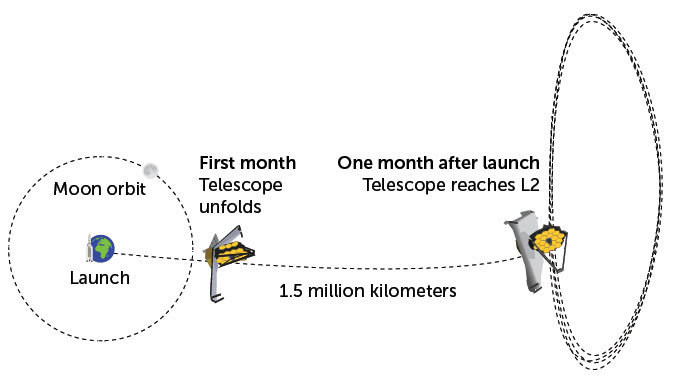
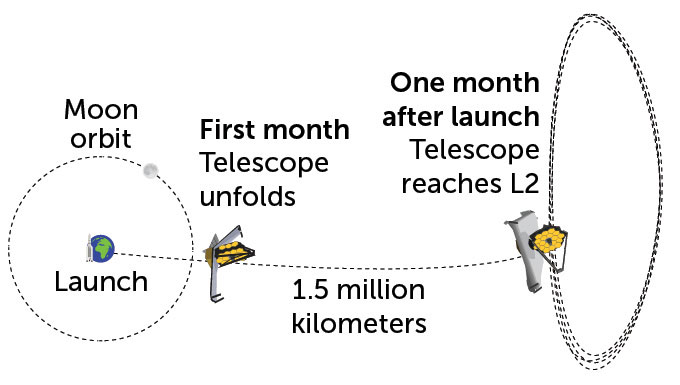
Tie breaker
The rate of expansion for the universe is known as the Hubble constant. For several years, different methods for measuring it have given different answers. Freedman calls the issue “the most important problem in cosmology.”
The question is whether the mismatch is real. That is, does how fast the universe expands really look different depending on how you measure it? If so, that could indicate something profound about the nature of dark energy. But the differences between measurements might just be due to errors.
Webb can help settle that debate.
One way to measure the Hubble constant is to measure the distances and speeds of far-off objects whose brightness is known. If you know its actual brightness, you can calculate the object’s distance based on how bright it looks from Earth. Objects of known brightness are called “standard candles.”
Exploding stars, or supernovas, are standard candles. So are special stars that give off pulses of light. These stars are called Cepheid variables. Studies using those standard candles have found one expansion rate for the universe. That rate is 74.0 kilometers (46 miles) per second for every 3 million light-years of space. But red giant stars are also standard candles. Studies using them have gotten a smaller expansion rate. That rate is only 69.8 kilometers (43 miles) per second per 3 million light-years.
Another way to measure the Hubble constant is to look at the cosmic microwave background. This dim glow of light was emitted just 380,000 years after the Big Bang. Calculations based on that glow give an even smaller expansion rate. They measure just 67.4 kilometers (42 miles) per second per 3 million light-years.
These numbers may seem close. But the fact that they disagree at all is a big deal. It could change our understanding of what the universe contains and how it evolves over time. For scientists, this mismatch is a crisis.
In its first year, Webb will observe several standard candles. It will look at Cepheid variable stars and red giants. It will also observe strange stars called carbon stars.
What’s more, the telescope will try to measure the Hubble constant another way. Webb will look at a galaxy that has been gravitationally lensed. That is, a distant galaxy whose light has been distorted and magnified by the gravity of a closer galaxy. Measuring the time it takes light to travel from the distant galaxy, through the closer galaxy, and finally to Webb can help measure the Hubble constant indirectly.
Astronomers will compare all those measurements. These data can also be checked against similar observations made by the Hubble Space Telescope.
Without these new observations, “we were just going to argue about the same things forever,” Freedman says. “We just need better data.” Now, Webb is about to deliver those data.
Transit advantages
Webb will measure the gases in exoplanet atmospheres by looking at the light from the planet’s host star as the planet crosses in front of the star. Atoms and molecules in the atmosphere — such as sodium (Na) and potassium (K) — absorb certain wavelengths of starlight. This leaves a unique fingerprint on the light that reaches Webb’s detectors.
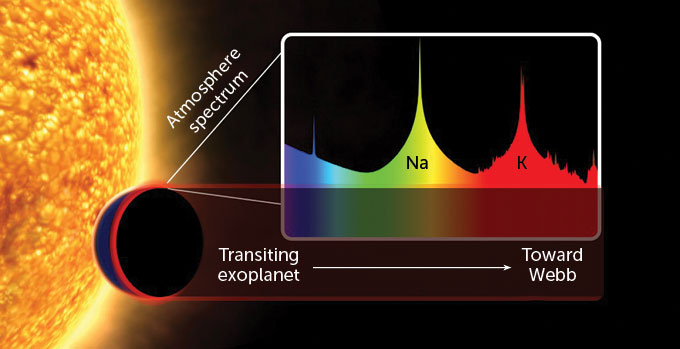
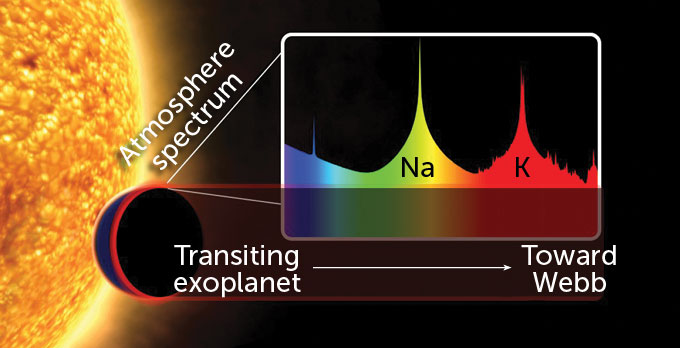
Looking for life
Perhaps the biggest change in astronomy during Webb’s development has been the rise of exoplanet science. “When [Webb] was proposed, exoplanets were scarcely a thing,” says Friedman. “Now, of course, it’s one of the hottest topics in all of science.”
One of Webb’s original goals was to detect Earthlike planets around other stars. There, it could search for evidence of life. But 25 years ago, only a handful of planets orbiting other sunlike stars were known. And all of those worlds were scorching-hot gas giants. They looked nothing like Earth at all.
Since then, thousands of exoplanets have been found orbiting distant stars. Scientists now think there is at least one planet for every star in the sky. Some of those planets are small and rocky, with the right temperature for liquid water. That makes them promising spots to look for life.
Most of these exoplanets were discovered as they crossed, or transited, in front of their parent stars. As a planet does this, it blocks a little bit of the star’s light. This reveals its presence to astronomers. What’s more, if that planet has an atmosphere, the starlight behind it filters through that gas. By peering at that filtered starlight, a sensitive telescope can tease out the gases in the atmosphere.
Two space telescopes have already started this work. One is Hubble. The other is the Spitzer Space Telescope. Like Webb, Spitzer observes infrared light. But Spitzer ran out of coolant in 2009. As a result, the telescope is too warm to measure important molecules in exoplanet atmospheres. Hubble, meanwhile, is not sensitive to some of the most interesting wavelengths of light. These are the wavelengths that could reveal alien life.
That’s where Webb is going to shine.
When it comes to observing exoplanets, using Hubble is like peeking through a crack in a door. But Webb will throw that door wide open, says Nikole Lewis. She studies exoplanets at Cornell University in Ithaca, N.Y.
Unlike Hubble, Webb is sensitive to several molecules that contain carbon. Such molecules in an exoplanet atmosphere could be signs of life. “Hubble can’t tell us anything really about carbon, carbon monoxide, carbon dioxide, methane,” Lewis says. But Webb can.
If Webb had launched in 2007 as planned, it could have missed this whole field. Back then, only a couple dozen transiting exoplanets were known. That radically changed between 2009 and 2018. During that decade, NASA’s Kepler space telescope spotted thousands of transiting planets. Many were too dim and distant for Webb to probe their atmospheres. But since 2018, NASA’s Transiting Exoplanet Survey Satellite, or TESS, has taken up the search. Its job is to find planets orbiting the brightest, nearest stars. These will give Webb the best shot at detecting interesting molecules in planet atmospheres.
If Webb launched earlier, it would have had to wait for TESS to pick the best targets. Now, Webb can get started on those worlds right away. So Webb’s delayed launch has actually been good for such studies, Lewis says. “The launch delays were one of the best things that’s happened for exoplanet science with Webb,” she says.
Webb’s first year of observations will include several exoplanets that look like promising places to find life. Scientists will also survey planets orbiting small, cool stars called M dwarfs. Those observations could help make sure such planets even have atmospheres. Astronomers have been hotly debating that for a while. If signs of life do show up on any of these planets, that will be hotly debated, too, Lewis says. “There will be a huge kerfuffle.”
A limited lifetime
Webb finally launched from French Guiana on December 25, 2021. For scientists who have been working on Webb for decades, this is a nostalgic moment. “You start to relate to the folks who built the pyramids,” Stiavelli says.
Other scientists have grown up in a world where Webb was always on the horizon. That generation is already thinking about the next big thing. “I’m pretty sure, barring epic disaster, that [Webb] will carry my career through the next decade,” Lewis says. Then, she wonders, what’s next?
The Hubble telescope has lasted decades, thanks to fixes and upgrades made by astronauts. But Webb won’t have that luxury. This space telescope has a strictly limited lifetime. It orbits the sun too far from Earth to repair. And it will need to burn small amounts of fuel to stay in position. The fuel is only guaranteed to last for five years. With luck, it could last more than twice that long. But when the fuel runs out, Webb is finished. The telescope operators will retire it to an out-of-the-way orbit around the sun. Then, astronomers will have to bid it farewell.







